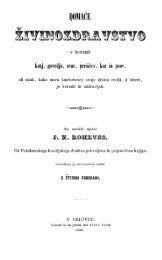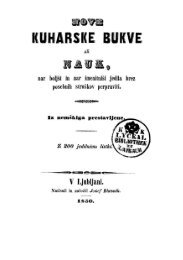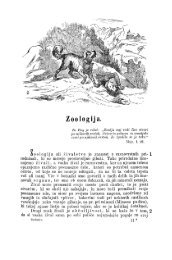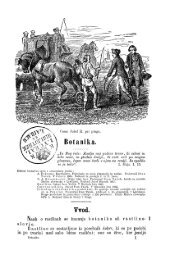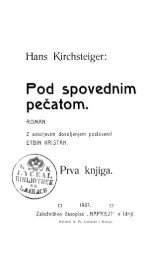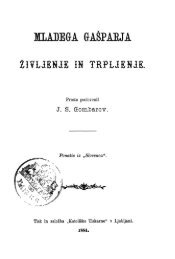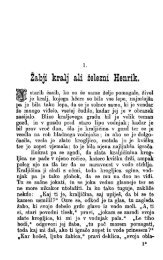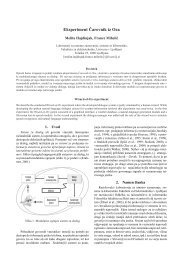Proceedings - Natural Language Server - IJS
Proceedings - Natural Language Server - IJS
Proceedings - Natural Language Server - IJS
Create successful ePaper yourself
Turn your PDF publications into a flip-book with our unique Google optimized e-Paper software.
forms of Croatian proper names, but we include first names,<br />
surnames, and toponyms in addition to organization names.<br />
To the best of our knowledge, we are the first to use<br />
supervised machine learning for named entity recognition<br />
and classification in Croatian language. Using a machine<br />
learning method, we avoid the need for specialized linguistic<br />
knowledge required to design a rule-based system. This<br />
way we also avoid the explicit modelling of complex dependencies<br />
between rules and their application order. We<br />
instead focus on designing a rich set of features and let the<br />
CRF algorithm uncover the dependencies between them.<br />
3. Corpus Annotation<br />
The training and testing corpus consists of 591 news<br />
articles (about 310,000 tokens) from the Croatian newspaper<br />
Vjesnik, spanning years 1999 to 2009. The preprocessing<br />
of the corpus involved sentence splitting and tokenization.<br />
For annotation we used seven standard MUC-7<br />
types: Organization, Person, Location, Date, Time, Money,<br />
and Percent. We also introduced five additional types: Ethnic<br />
(names of ethnic groups), PersonPossessive (possesive<br />
adjectives derived from person names), Product (names<br />
of branded products), OrganizationAsLocation (organization<br />
names used as metonyms for locations, as in “The<br />
entrance of the PBZ bank building”), and LocationAsOrganization<br />
(location names used as metonyms for organizations,<br />
as in “Zagreb has sent a demarche to Rome”).<br />
The additional types were introduced for experimental reasons;<br />
in this work only the Ethnic tag was retained, while<br />
other additional tags were not used (i.e., the Product tag<br />
was discarded, while the remaining three subtype tags were<br />
mapped to the corresponding basic tags). Thus, in the end<br />
we trained our models using eight types of named entities.<br />
The annotation guidelines we used are similar to MUC-<br />
7 guidelines, with some adjustments specifically for the<br />
Croatian language. The corpus was independently annotated<br />
by six annotators. To ensure high annotation quality,<br />
the annotators were first asked to independently annotate a<br />
calibration set of about 10,000 tokens. On this set, all the<br />
disagreements have been resolved by consensus, the borderlines<br />
were discussed, and the guidelines revised accordingly.<br />
Afterwards, each of the remaining documents was<br />
annotated by two independent annotators, while a third annotator<br />
resolved the disagreements. For annotating we used<br />
an in-house developed annotation tool.<br />
The inter-annotator agreement (calculated in terms of<br />
MUC F1 and Exact F1 score and averaged over all pairs of<br />
annotators) is shown in Table 1. The inter-annotated was<br />
measured on a subset of about 10,000 tokens that was annotated<br />
by all six annotators. Notice that the overall quality<br />
of the annotations improved after resolving the disagreements,<br />
but – because each subset was resolved by a single<br />
annotator – we cannot objectively measure the resulting improvement<br />
in annotation quality.<br />
4. CroNER<br />
CroNER is based on sequence labeling with CRF. We<br />
use the CRFsuite (Okazaki, 2007) implementation of CRF.<br />
At the token level, named entities are annotated according<br />
to the Begins-Inside-Outside (B-I-O) scheme, often used<br />
74<br />
Table 1: Inter-annotator agreement<br />
Tag F1 Exact F1 MUC<br />
Person 98.05 98.55<br />
Ethnic 97.19 97.19<br />
Percent 92.00 96.77<br />
Location 93.95 94.93<br />
Money 91.95 94.15<br />
Organization 89.35 93.58<br />
Date 71.47 85.79<br />
Time 67.55 71.04<br />
for sequence labeling tasks. Following is a description of<br />
the features used for sentence-level label prediction and the<br />
techniques for imposing document-level label consistency.<br />
4.1. Sentence-level features<br />
Most of the features can be characterized as lexical,<br />
gazetteer-based, or numerical. Some of the features were<br />
templated on a window of size two, both to the left and to<br />
the right of the current word. This means that that the feature<br />
vector for the current word consists of features for this<br />
word, two previous words, and two following words.<br />
Lexical features. The following is the list of the lexical<br />
features used (templated features are indicated as such).<br />
1. Word, lemma, stem, and POS tag (templated) – For<br />
lemmatization we use the morphological lexicon developed<br />
by ˇSnajder et al. (2008). For stemming, we<br />
simply remove the word’s suffix after the last vowel<br />
(or the penultimate vowel, if the last letter is a vowel).<br />
Words shorter than 5 letters are not stemmed. For POS<br />
tagging, we use a statistical tagger with five basic tags.<br />
2. Full and short shape of the word – describe the ordering<br />
of uppercased and lowercased letters in the<br />
word. For example, “Zagreb” has the shape “ULL-<br />
LLL” and short shape “UL”, while “iPhone” has the<br />
shape “LULLLL” and short shape “LUL”.<br />
3. Sentence start – indicates whether the token is the first<br />
token of the sentence.<br />
4. Word ending – the suffix of the word taken from the<br />
last vowel till the end of the word (or the penultimate<br />
vowel, if the last letter of the word is a vowel).<br />
5. Capitalization and uppercase (templated) – indicates<br />
whether the word is capitalized or entirely in uppercase<br />
(e.g., an acronym).<br />
6. Acronym declension – indicates whether the word is<br />
a declension of an acronym (e.g., “HOO-om”, “HDZa”).<br />
Declension of acronyms in Croatian language follows<br />
predictable patterns (Babić et al., 1996).<br />
7. Initials – indicates whether a token is an initial, i.e., a<br />
single uppercase letter followed by a period.<br />
8. Cases – concatenation of all possible cases for the<br />
word, based on morpho-syntactic descriptors (MSDs)




